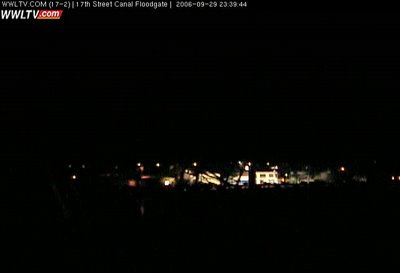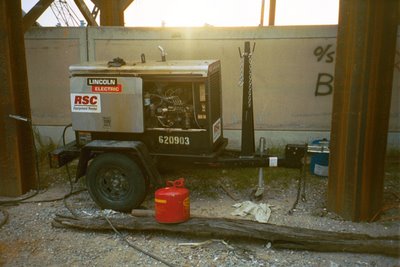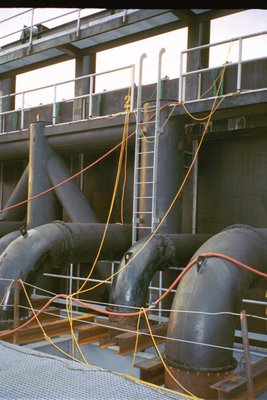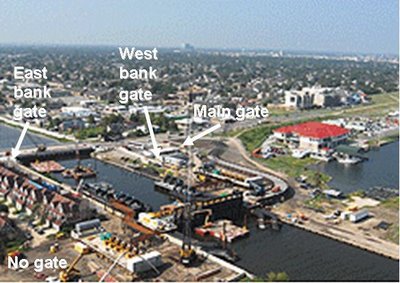Problems at the floodgates - Part 4
Part 2
Part 3
Part 4: Urgency is gone
Deep Flood tells me that the 17th Street pictures were all taken between 6 and 7 PM. The London Avenue photos were taken after dark. As you can see, there's no one around in any of the photos, or else Deep Flood would have gotten shooed away. It's just more evidence that the Corps has gone back to business as usual.
There is no urgency left in the Corps' work at 17th Street, which is tragic, because there is still a critical need for more pumping. Do a Google search on "17th Street," "gates," and "around the clock," and you'll find articles as recently as May showing the site lit up like a movie set while work was going on. But, if you've been reading my blog regularly, you know from the Clock of Shame that the Corps hasn't been working nights for a while.
Was there ever any urgency around the pumps? First a little background info.
Before the storm, the capacity of the 17th Street canal was about 10,000 cubic feet per second (cfs). In January, the Corps decided to only purchase enough pumps to flow 2800 cfs around the gates when they close. Their eventual design calls for 7300 cfs by next June 1.
At London Ave., the prestorm capacity was about 8000 cfs. In January, the Corps decided to only purchase enough pumps to flow 2800 cfs around the gates when they close. Their eventual design calls for 4800 cfs by next June 1.
At Orleans Ave., the prestorm capacity was about 2550 cfs. In January, the Corps decided to only purchase enough pumps to flow 2200 cfs around the gates when they close. 2200 is the final amount caled for by the Corps.
So it's not like they don't know about the acute need for extra pumping capacity. They've known it right from the beginning in January, when they only ordered 12 pumps for 17th Street, 12 for London Ave., and 10 Orleans Ave. Here's the original pumping solicitation. The quantities are on pages 2 and 3. As I said above, all of those quantities result in capacities below the prestorm capacities. They also give no backup capacity in case pumps fail.
And they also knew they had to rectify the pumping shortfall immediately. Here's a drawing that has not been shown publicly before today. It shows a massive expansion of pumping at 17th Street along the Jefferson Parish side. Click on it to see it full size. If it's zoomed too big in your browser window, you can save it to your hard drive from the browser and open it with another program.
What is interesting is the date on the drawing:

February 27th! They were planning for extra pumps all the way back in February. What happened? Absolutely nothing until June 9th, when they finally issued a solicitation for extra pumps. They planned on getting 16 extra pumps at 17th Street (about an extra 3600 cfs) and 7 more at London Ave (about an extra 1600 cfs). But they cancelled it June 21st for fear of getting sued by a bidder that was about to lose the contract.
What's interesting is the drawing of the layout for the extra pumps (click to enlarge). Again, if it's zoomed too big in your browser window, you can save it to your hard drive from the browser and open it with another program.
It's almost exactly like the February 27th drawing. For reference, here's the entire package of drawings that went out with the extra pumps solicitation in pdf form.
This is called "churn" in bureaucratic-ese. Churn is doing the same thing over and over without any actual results. Between February and June, when the need was absolutely the highest to buy extra pumps, the Corps churned. So much for urgency.
And since June? They've wisely given the pump ordering task to Boh Brothers. Why didn't they do this in the first place? Boh purchased six extra pumps (where the need went for the extra ten the Corps wanted in June is unclear, as is the need for the extra pumps at London, though I've heard those pumps are still coming), two for the Orleans side, four for the Jefferson side. You saw the locations in Part 1. The Orleans side extra pumps were supposed to be working as of today. They are not. The Jefferson side pumps are supposed to be working as of October 31. They won't be, because the platforms for them have only barely begun to be built. From what I can tell, those Jefferson side pumps and engines are not even delivered yet.
Is the Corps working hard to catch up and get those pumps installed according to their own, publicly announced schedule? No. They only work during the daytime. According to the plainly available evidence, there's no urgency.
However, they are diligently still snowing the national media with their phony "we're working 24/7" routine. Here's a quote from the August 31 Washington Post:
"So the thing to do is rebuild, but for rebuilding to make sense you also have to protect. That's why I spent an afternoon this week at the London Avenue Canal, listening as Col. Jeffrey Bedey of the Army Corps of Engineers described the additions and repairs to New Orleans's manifestly inadequate flood-control system that crews are working around the clock [my emphasis] to complete."
They're saying the same stuff to the local media as well. This past Wednesday, September 27 on WLAE's "Road to Recovery," Brigadier General Robert Crear, Commander of the Mississippi Valley Division (which is one step above the New Orleans District), in response to the question of what is the most important thing to the Corps in their repair and reconstruction efforts, said this:
"Whatever we do, we have to have a sense of urgency."
And the mendacity extends to Corps Headquarters in Washington as well. As recently as this month, Corps HQ is still putting forth the myth that work is going on around the clock. Here's a quote from the Public Affairs office at the Corps' headquarters:
"According to James St. Germain, project manager in the Hurricane Protection Office (HPO), crews are working 24/7 to get the interim pumping structures ready at the three outfall canals. Once completed, the interim floodgates and pumping system will maintain water levels within the canals and lower the risk of floodwall failure. 'This has been an unprecedented operation with activity around the clock," said St. Germain. 'Our contractors have been very good and have really stepped up the pace to get these structures operational.'"
According to the available evidence, there hasn't been activity on a 24/7 basis out there for weeks, possibly months. There seems to be a disconnect between what the Corps says - the supposed urgency, the promises of extra pumping capacity, the schedules - and what is plainly visible on the construction site from the road.
Why is this? Either Boh Brothers has decided that other projects are more important, or the Corps has just given up now that the media spotlight is off of them. Whatever the reason, New Orleanians who depend on the swift completion of the project have been hung out to dry by the very people we're depending upon to help us.
What gives with these people? Why should we be any less valuable in September than we were in June?
Tomorrow: Part 5 - What can you do? And a bonus addition to part 4!











































